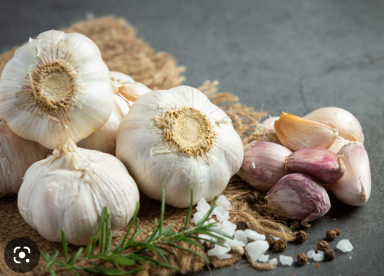Garlic: not only fights germs, but also prevents heart attacks.
Garden garlic is one of the oldest plants in the world cultivated by humans. The unpretentious perennial vegetable belongs to the onion subfamily, whose other representatives are leeks, chives, green onions and shallots, which, like their "relative" garlic, are distinguished by their pungent aroma and taste.
 The bulb of this plant, which consists of 8-20 cloves, is eaten. The cloves are teardrop-shaped and wrapped in a white parchment-like skin.
The bulb of this plant, which consists of 8-20 cloves, is eaten. The cloves are teardrop-shaped and wrapped in a white parchment-like skin.
Garlic is a Klondike of vitamins and minerals
Garlic contains sulfur compounds
Reduces the risk of heart attack
How does garlic treat bacterial infections?
Abstract: Garlic is a commonly used ingredient in cooking that has been valued for its medicinal properties for centuries. Garlic has been shown to have antibacterial properties and has been used to treat bacterial infections for many years. The purpose of this review is to provide an overview of the antibacterial properties of garlic and the mechanisms by which it can treat bacterial infections.
Introduction: Bacterial infections can cause a variety of illnesses and diseases, ranging from minor infections such as ear infections to life-threatening illnesses such as sepsis. The development of antibiotic resistance has made it increasingly difficult to treat bacterial infections with traditional antibiotics. Garlic is a natural alternative that has been used for centuries to treat bacterial infections. Garlic contains a compound called allicin that has been shown to have antibacterial properties.
Mechanism of action: Allicin is the active compound in garlic that is responsible for its antibacterial properties. When garlic is crushed or chopped, an enzyme called alliinase is activated, which converts alliin into allicin. Allicin has been shown to inhibit the growth of a wide range of bacteria, including antibiotic-resistant strains. Allicin works by disrupting the cell membrane of the bacteria, which leads to the leakage of the bacterial cell contents and eventually causes the death of the bacteria.
Clinical studies: Several clinical studies have investigated the antibacterial properties of garlic. One study found that garlic extract was effective against a variety of bacteria, including Escherichia coli and Staphylococcus aureus. Another study found that garlic was effective in inhibiting the growth of Helicobacter pylori, a bacteria that is responsible for stomach ulcers. Garlic has also been shown to be effective in treating urinary tract infections and ear infections.
Conclusion: Garlic has long been valued for its medicinal benefits, particularly its natural antibacterial properties. The compound allicin, found in garlic, disrupts bacterial cell membranes and contributes to the elimination of harmful microbes. While conventional antibiotics like Zithromax, including the Zithromax Z-Pak and Zithromax 500, remain frontline treatments for many infections, natural alternatives such as garlic are gaining attention. Some studies suggest that garlic may complement treatments involving azithromycin 250 mg or a full Zithromax pack, especially in cases involving resistant strains. Although Zithromax antibiotics like Z-Pak Zithromax, Azivista, Azit, or Onazit offer fast, targeted action, garlic presents a promising, natural option for further exploration in the fight against bacterial infections.